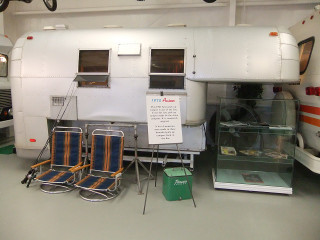 In many ways, it’s remarkable how slowly things change in the world of RVs. We look at brand-new
rigs on dealer lots, we visit an RV Museum, and both are
remarkably similar to our own 11-year-old camper. And even after returning from our
eight-year hiatus, there was very little that
looked different on the roads and in the campgrounds. State parks and diesel are more expensive,
but picnic tables and utility hookups are eternal.
In many ways, it’s remarkable how slowly things change in the world of RVs. We look at brand-new
rigs on dealer lots, we visit an RV Museum, and both are
remarkably similar to our own 11-year-old camper. And even after returning from our
eight-year hiatus, there was very little that
looked different on the roads and in the campgrounds. State parks and diesel are more expensive,
but picnic tables and utility hookups are eternal.
Internet connectivity, though… that’s another story. Our need for it hasn’t changed a bit: it was crucial to our income eleven years ago, and it’s equally so now, even as the nature of that income has shifted. What has really changed is the range of options for maintaining that connection. Hell, just the fact that there are options, that’s new. We have exercised several of those options, and at one time or another, we rely on each of them.
Here are our current pathways to the ‘net, as of the beginning of 2014.
Millenicom MiFi
Seems like everyone who RVs seriously has jumped on board with Millenicom,
and for good reason: they’ve historically been the most versatile and economical cellular data
provider (technically an MVNO, a reseller of service from the cellular network owners). Until
recently, they offered a range of options for getting all your gear online, from “air card” (USB
cellular modem) to “MiFi” (an all-in-one portable wifi hotspot), with Bring Your Own Device
plans on the side.
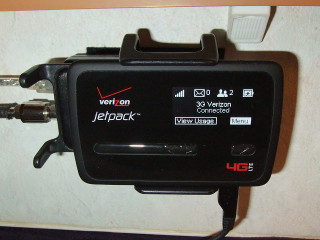 We went the MiFi route – despite having a wealth of devices we could potentially
bring – because it was the only plan on Verizon’s network. Say what you will about Verizon,
but their coverage in remote areas of the USA is second to none.
We went the MiFi route – despite having a wealth of devices we could potentially
bring – because it was the only plan on Verizon’s network. Say what you will about Verizon,
but their coverage in remote areas of the USA is second to none.
As an aside, apparently Millenicom recently lost their Sprint MVNO status, and have replaced their air-card and BYOD plans with iPad-based offerings on T-Mobile’s network. If you’re open to buying an Apple tablet anyway, and T-Mobile’s coverage map suits you, it’s a good deal, but is of no interest to us.
But coming back to Verizon: it’s a bit surprising how big their 4G-LTE footprint is, really. We spent months traveling up the east coast last summer, and 4G was with us at every stop along the way. I don’t think we lost coverage from when we descended the Virginia piedmont until we got up into New Hampshire’s White Mountains. And when you’ve got it, LTE is unbeatable – it truly is mobile broadband. Speeds of 10 megabits per second are common, 20+ not unheard-of, even in some areas where you look around and say, where is everyone?
But not everywhere, of course. 4G-LTE is the latest-and-greatest cellular data tech at the moment, and because it's the newest, its footprint is the smallest. There are still many areas where the older generations are the only game in town, and as you get deeper into legacy territory, the speeds drop accordingly. A good Versizon 3G signal averages about 1 megabit per second, nowhere near 4G but better than nothing; this is probably just about at the lower end of what's usable for ordinary online work without being driven mad. Move further down the scale to a weak 3G signal, 2G, or (god forbid) 1G, and the speed becomes too slow for most tasks. You might be able to pick up email, or load a very basic, lightweight web page, but that's about it.
Protip: Because phone apps and mobile-optimized websites acknowledge that you won't always have a fat pipe, a smartphone or tablet is often the best choice for utilizing a slow MiFi signal like 2G or weak 3G.
Cost
Equipment: $165 ($100 MiFi, $50 setup, $15 shipping)
Service: $70 per month
Bandwidth Cap
20GB per month
Wilson Antenna and Booster
Whatever the technology, the footprint still has holes, and one of the biggest on the eastern seaboard
surrounds the National Radio Quiet Zone on the
West/Virginia border – and we spent two months roaming around the edge of that hole
 last spring. One way to effectively make the holes smaller is by boosting the cellular
signal, usually with some combination of antenna and amplifier, and we have gone that route
too. Our combination is made by Wilson Electronics,
and consists of a
“Trucker”
antenna connected to a booster
cradle that the MiFi sits in. It’ll generally add one or two “bars” (about 20dB gain) to our
3G signal strength in marginal areas; not only can that mean the difference between being online
and not, but stronger cellular signal usually also equates to a faster connection.
last spring. One way to effectively make the holes smaller is by boosting the cellular
signal, usually with some combination of antenna and amplifier, and we have gone that route
too. Our combination is made by Wilson Electronics,
and consists of a
“Trucker”
antenna connected to a booster
cradle that the MiFi sits in. It’ll generally add one or two “bars” (about 20dB gain) to our
3G signal strength in marginal areas; not only can that mean the difference between being online
and not, but stronger cellular signal usually also equates to a faster connection.
You may notice that I’m only talking about 3G signal here, not 4G. That’s because our particular
antenna+booster combination doesn’t operate in the 4G frequency bands, only in the older 1-3G
ranges. Meaning that it's no help in closing the 4G holes, but will help us pull in 3G when that's all
that's available. And why don't we have 4G booster? Well…
We bought it during a desperate weekend outside Beckley, WV, when we really needed
the boost; this was the best that was available locally, and we couldn’t afford to wait for
4G-compatible gear to be delivered to us. It’s one of the downsides of fulltiming: sometimes you
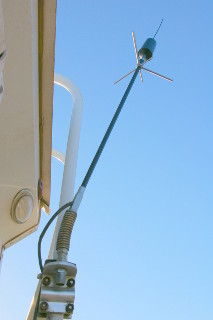 have to buy what’s local, rather than what you really want (a bit of a throwback to the pre-Web
era, actually). The antenna has also suffered during the eight months it’s been mounted to our
ladder; the mounting spring started rusting almost immediately, and at some point we lost part
of the ground plane, probably to a low-hanging tree branch. So even apart from rusting, that spring’s
not even doing its job well; you can see in the photo at right that it doesn't hold the antenna vertically
anymore either.
have to buy what’s local, rather than what you really want (a bit of a throwback to the pre-Web
era, actually). The antenna has also suffered during the eight months it’s been mounted to our
ladder; the mounting spring started rusting almost immediately, and at some point we lost part
of the ground plane, probably to a low-hanging tree branch. So even apart from rusting, that spring’s
not even doing its job well; you can see in the photo at right that it doesn't hold the antenna vertically
anymore either.
For all of these reasons, I expect we’ll replace the antenna and booster combination, probably in the next year or so. Obviously, something with multi-band LTE compatibility is a must, but I’m also looking at redoing the mount. My thinking right now is a marine swivel mount, attached near the top of the ladder, that I can manually swing up (for use) or down (for travel), avoiding the spring issues altogether. I’ll post back here with an update in any case.
Cost
Equipment: About $150 as of this writing ($50 Trucker antenna, $100 Sleek booster)
Android Hotspot
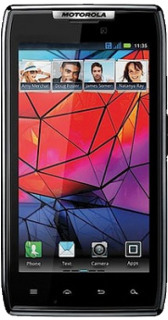 Even with a booster, Verizon’s coverage has gaps, but some of those gaps are covered by
other cellular networks. And because Millenicom’s plan is data-only, we needed another
provider for voice service anyway. After surveying the alternatives, I settled on
Straight Talk, an AT&T MVNO. I mostly use it in
my daily-driver smartphone, but it also serves as a backup for the MiFi. When it happens
that AT&T’s network has better coverage in a given location than Verizon’s, any of
our Android handsets can serve as a hotspot for the duration – and as a bonus, can
use the same booster cradle that the MiFi usually lives in. After some experimentation, I’ve
found that an old Motorola RAZR has the best cellular radios of any phone we currently have
in-house, so it usually pulls hotspot duty when such is required. It’s not needed often,
but it’s good to have.
Even with a booster, Verizon’s coverage has gaps, but some of those gaps are covered by
other cellular networks. And because Millenicom’s plan is data-only, we needed another
provider for voice service anyway. After surveying the alternatives, I settled on
Straight Talk, an AT&T MVNO. I mostly use it in
my daily-driver smartphone, but it also serves as a backup for the MiFi. When it happens
that AT&T’s network has better coverage in a given location than Verizon’s, any of
our Android handsets can serve as a hotspot for the duration – and as a bonus, can
use the same booster cradle that the MiFi usually lives in. After some experimentation, I’ve
found that an old Motorola RAZR has the best cellular radios of any phone we currently have
in-house, so it usually pulls hotspot duty when such is required. It’s not needed often,
but it’s good to have.
One big “hole” in the Millenicom/Verizon coverage map is a region known as Canada – the MiFi simply doesn’t do international roaming. So during our time in the great white north this autumn, I picked up a SIM card from Similicious, and stuck it in the trusty RAZR. I expect I’ll do the same the next time we venture over the border.
Cost
Equipment: Depends. I already had the phone for my gig as an Android app dev, so it cost me nothing extra to use it for this. If you don’t have a suitable phone… as of this writing, you can pick up a Moto RAZR on Ebay for about $100.
Service: $50 per month ($45 if you pay automatically by credit card)
Bandwidth Cap
2.5GB per month
DataStorm and HughesNet
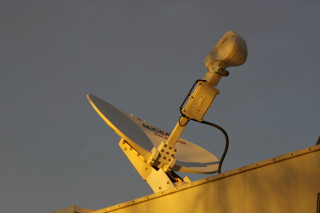 No matter what hacks and amplifications you use, the cellular networks simply do not cover
everywhere. Specifically, they don't cover some of the best places in the US – because
some of the best places are in the big national parks, and almost by definition are also some of
the most remote places. For us, this is where we really want to be. And satellite internet is
the only way to maintain our connection there.
No matter what hacks and amplifications you use, the cellular networks simply do not cover
everywhere. Specifically, they don't cover some of the best places in the US – because
some of the best places are in the big national parks, and almost by definition are also some of
the most remote places. For us, this is where we really want to be. And satellite internet is
the only way to maintain our connection there.
Everyone likes to dis on satellite internet. As I see it, half of the people doing so are those who have it, and recognize its (many) shortcomings. And half are those who don't have it, and perhaps – secretly – wish they did. Call it dish envy. Yeah, we're undoubtedly spoiled because we made the investment in a DataStorm back in the day, when there really was no cellular data network. But it's still an essential part of our connectivity puzzle, and for all its issues, we wouldn't give it up.
And wow, does it have issues. In the 16 months that we’ve been back on the road, we’ve had to replace the satellite modem, main mount bushing, LNB+transmitter, and the indoor dish controller – and it looks like only a matter of time until the latter needs replacing again (or perhaps it’s the upper control board, it’s hard to tell). Apart from the bushing (only $55), all of these items are multiple hundreds of dollars. Most of the time, the system is mostly functional, but I’ve identified no less than 6 distinct problems with it, any one of which will prevent it from getting online by itself.
But I digress.
It’s not even clear how long we can keep the system going. The manufacturer, MotoSat, went out of business last year, a casualty of the expanding cellular data networks and the contracting RV business. So, the only replacement parts available these days are what dealers still have in stock, or what they can salvage from decommissioned systems. Fortunately, the actual satellite gear isn’t RV-specific; those components are standard (albeit legacy) HughesNet components, the same as you see on myriad gas stations nationwide.
Most of what I wrote in my original DataStorm article still stands – and you’ll be able to tell what doesn’t. What’s changed (apart from MotoSat going bust, and DirecWay changing its name to HughesNet) is that we’re no longer reliant on the DataStorm alone, and that’s a good thing. It’s great to have it, but it’s also great to not have to use it all the time.
Cost
Equipment: $5700 in 2002. More recently, we’ve invested over $1300 (as well as several days work by yours truly) in keeping the unit updated and repaired.
Bandwidth Cap
425MB per day; theoretically, a maximum of 12.5GB per month
GlobalStar Satellite Phone
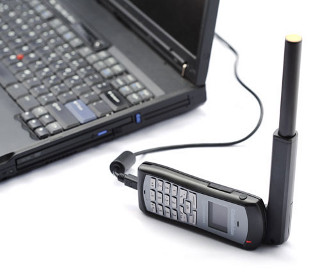 When were heading into Newfoundland and
Labrador, I knew that we’d be far out of cellular data
coverage, and expected that we’d be outside the DataStorm satellite footprint as well. So
we bought a GlobalStar satellite phone (under the
SPOT brand), both to maintain basic connectivity,
and to make emergency voice calls if necessary.
When were heading into Newfoundland and
Labrador, I knew that we’d be far out of cellular data
coverage, and expected that we’d be outside the DataStorm satellite footprint as well. So
we bought a GlobalStar satellite phone (under the
SPOT brand), both to maintain basic connectivity,
and to make emergency voice calls if necessary.
Why was this going to provide better coverage than our existing satellite connection? It’s to do with the nature of the satellites involved. Here’s a simplified version: Our DataStorm / HughesNet service comes through a single satellite in geosynchronous orbit, which puts it high over the Earth’s equator. This means that the further north you go, the further around the planet’s curvature you get; eventually, you can’t see the satellite at all anymore. The GlobalStar phone uses a constellation of satellites in Low Earth Orbit (LEO), and these aren’t latitude-limited in the same way. So you can get coverage further afield.
However, this didn’t pan out quite as expected. First, the DataStorm managed to get online
much further north than I’d thought it would, all the way to 53°N latitude; this meant that we
didn’t need an alternative connection anywhere near as much as we expected. Second, we found
good wifi in Happy Valley, Churchill Falls, and Labrador City, three of the more remote towns
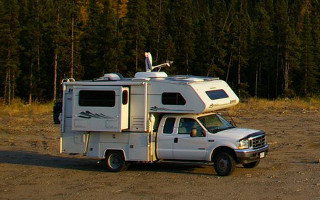 on the Trans-Labrador Highway.
on the Trans-Labrador Highway.
But finally, it turned out that the GlobalStar data connection (laughingly called Express Data) was just too damn slow to be usable. Of the two times that I tried, once I managed to receive a single email, and once I didn’t manage to do anything at all. My suspicion was that, because most modern net connections have decent speed, there is just too much overhead in the data protocols in use, too much going on in the background. Most of the time, this doesn’t matter, but on a connection this slow, it’s deadly.
Cost
Equipment: $530 ($500 phone + $30 USB data cable)
Service: $40 per month (paid as $480 per year)
Bandwidth Cap
960 minutes per year ( = 80 minutes per month); theoretically, a maximum of about 5.5MB per month at 9600bps
External WiFi
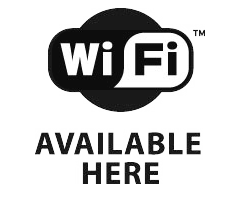 By which I mean, through a campground, a public library, or a venue like Starbucks. I know there
are fulltimers who rely on these networks, sometimes even as their only connection, but we’ve not
often found them useful. Campground wifi is pretty rare in the places we stay, and when we do find
it, it’s seldom fast and reliable enough for us to use it in preference to one of our own connections.
In addition, it often costs a few dollars a day; if you were using it frequently, this would quickly
add up to as much in a month as Millenicom or HughesNet service costs. Perhaps if you only need to
pick up email once or twice a week, it’d be fine – but if you’re working online for hours
most every day, it’s just not a viable option.
By which I mean, through a campground, a public library, or a venue like Starbucks. I know there
are fulltimers who rely on these networks, sometimes even as their only connection, but we’ve not
often found them useful. Campground wifi is pretty rare in the places we stay, and when we do find
it, it’s seldom fast and reliable enough for us to use it in preference to one of our own connections.
In addition, it often costs a few dollars a day; if you were using it frequently, this would quickly
add up to as much in a month as Millenicom or HughesNet service costs. Perhaps if you only need to
pick up email once or twice a week, it’d be fine – but if you’re working online for hours
most every day, it’s just not a viable option.
So, we mostly ignore other peoples’ wifi. Every now and then, it’ll come through for us, or we’ll be desperate enough to seek it out, but most of the time, we stick with our own.
Cost
Varies, though we very rarely pay for it.
Bandwidth Cap
Varies. Unlimited in most public venues, limited in many campgrounds.
Bringing It All Together
These various options mean that virtually anyplace we park the rig, we have at least one pathway to the Internet, and frequently we have several. And that’s a good thing too, because all of these pathways share a common limitation, detailed in each section above: bandwidth caps.
As our connection of choice, the Millenicom MiFi bears the brunt of our traffic, and its 20GB/month is okay – as long as we’re careful. The big killers are streaming video and software updates; the former is entirely within our control, but the latter can be a challenge. We’ve switched to manual updates on every device and software package that we can, but there are some that we can’t control, and it’s not uncommon for one of those to start up and drain a few gigabytes of our quota before we notice and shut it down. Seriously, everybody in Silicon Valley writing this software just assumes that wifi means unlimited bandwidth these days.
The satellite link works a bit differently: its limit is per day, rather than per month. I’m sure that 425MB seemed like plenty when Hughes put the service together around the turn of the millenium, but these days, it’s peanuts. When we’re dependent on that connection, we have to be extremely careful about what’s using bandwidth and when – a few hundred megabytes is nothing to a modern software update. On the other hand, when we do have Verizon coverage as well, we can use the satellite link to do a sort of load-balancing: we use the MiFi for regular tasks, but when we know something will need a big download, we connect it through the DataStorm instead. If it empties the bandwidth bucket doing its thing, that’s OK – it’ll be full again tomorrow – unlike the MiFi, which won’t refill until the end of the month.
So we do need to be careful, but the vast majority of the time, we do have a connection – and considering the circumstances, it’s generally pretty good. And because we almost always have this link, we’ve built our RV lifestyle around it. Work is the example that I keep coming back to, but the Internet is also where we go to relax in the evening, or for the ongoing research of where we’re headed next – not to mention updating this website. Our families have long since learned that email is the best way to reach us, and we handle virtually all our personal business online. Our Internet connection is our lifeline to the wider world.